SilverStone ML09B Mini-ITX Case Review
Pros
Cons
Rating
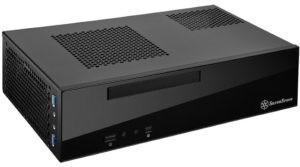
Here at The Tech Buyer’s Guru, we always start our case reviews by noting that we’ve reviewed more PC cases than any other category of product. With this review, we’re now up to 24 (making it a solid two-dozen that we’ve been hands on with!). So you could say we have a pretty good sense of what makes a great case, and where the simply average cases fail.
One company that’s always been on the cutting-edge of case design is SilverStone. It was the first to introduce the shoebox ITX case design to the DIY market with the SG05, which lives on as the SG13 today, the first to use inverted layouts to improve cooling, as in the TJ08-E, and one of the first to integrate RGB into its cases with the PM01-RGB. SilverStone clearly isn’t afraid to try new things when it comes to PC cases. That’s why we were so eager to test out the ML09, its newest ultra-slim HTPC-focused case. While the Milo (ML) series has plenty of members, #9 may well bring together the latest in small form factor chassis design to provide the ultimate ultra-compact solution for enthusiasts. Read on to see if it has what it takes to stand out!
Special thanks to SilverStone for providing us a sample of the SilverStone ML09B Mini-ITX Case featured in this review.
Description and Features
We’re always excited to see innovation in the SFF market, and the ML09 is the epitome of a well-considered design. That’s not just sheer luck; SilverStone has redesigned its ML ITX chassis a number of times in order to get it right. It all started with the ill-conceived ML05, launched in 2013, which came in at the exact same 7 liters as the ML09, yet required a slot-loading optical drive and could not fit dual-slot video cards. Then came the ML06 and ML06-E, and finally the ML09 you see here. The three key changes over time were the swapping of components inside the chassis, the exchanging the slot-loader for a more practical tray-loading optical drive bay, and giving the ML a sleek, appealing façade that still allowed SilverStone to keep the price low. The ML06-E, for example, came in at $15 more due to a fancy aluminum faceplate, and also required a much more expensive slot-loading drive. Note that SilverStone took a detour with the ML series when it released the ML07 and ML08, both much larger cases that supported high-end video cards, and one could have surmised that the company had given up on its 7-liter model. Luckily, it just needed to learn from its mistakes!

What’s amazing is that the exterior dimensions of the ML ITX chassis have remained virtually unchanged since 2013: the ML09 is 13.78″ (W) x 3.9″ (H) x 8.07″ (D). It’s hard to gauge just how small that is based on the numbers or even by looking at a photo of the case without some context. Therefore, we’ve put together a set of photos here comparing the ML09 to its cousin the 12-liter RVZ02, which is essentially identical to the ML08 that preceded the ML09. As can be plainly seen, while these two cases are similar in width, there are most definitely not the same size. The RVZ02/ML08 is nearly twice as deep, which makes it feel a lot bigger in person. The ML09 can easily fit in just about any bag, for example, making it extremely portable, and it will also sit neatly on any desk or shelf.
Of course, being about half the size of the ML08, and about one-sixth the size of your typical ATX mid-tower case, does come with its compromises. First off, this is a mini-ITX chassis, meaning you get one expansion slot, although SilverStone has wisely made that a double-wide slot in the ML09. There’s also an accessory slot, as shown the the photo below, which at this point is essentially useless (back in 2013 when it debuted on the ML05, this slot could have been used for the then-common USB and FireWire adapters that connected directly to a motherboard without using PCIe slot). The other big trade-off is that the double-wide video card slot is quite limited in terms of both length and height. You will need to use not only a low-profile card, but also a card under seven inches long. The very best such card on the market as of this writing is the Gigabyte Geforce GTX 1050 Ti OC Low Profile 4GB, which we unfortunately do not have on hand to test. Therefore, we went without a video card in this review, relying on onboard video. This is an approach we assume most ML09 buyers will end up making despite the opportunity to do otherwise.
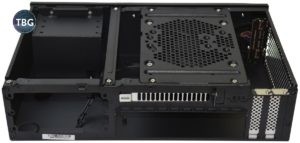
Another drawback to a really small chassis is that you have to do a lot of disassembly before you actually start building. Whether it’s installing the motherboard, the power supply, an optical drive, or 2.5″ data drives (the ML09 can hold four), you’re going to have to take things apart before you put them together. We understand that it makes sense to ship the ML09 fully assembled just to keep parts intact without additional packaging, but ideally we’d love to see the ML09 shipped with each of its modular parts removed to aid in assembly.
One thing we should note about the ML09’s specifications is that SilverStone lists a somewhat nebulous CPU cooler limit of “37~70mm (variable based on use of multipurpose bracket).” That’s a pretty wide range, and will leave a lot of builders guessing as to what it actually means. Well, here’s the story: if you want to use a 70mm cooler, you need to take the multipurpose bracket out entirely. That means no optical drive, no hard drive, and no 120mm fan (which is pre-installed on the bracket, by the way). If you want to run either the slim 15mm fan or an optical drive, your CPU clearance drops to 47mm (the height of the stock Intel cooler). And if you want a 3.5″ drive in that bracket, your clearance drops to 37mm. The same goes for using a standard 25mm-thick case fan. From our point of view, SilverStone should list the CPU cooler clearance as shipped, which is 47mm. Furthermore, the multi-purpose is sort of a misnomer; the bracket is multi-uni-purpose, in that you can only use it for one component at a time.
Of course, being enthusiasts, we decided to test the limits of this case by actually installing a 70mm cooler, and there is honestly only one such cooler to consider: the unrivaled Noctua NH-L12S, shown below. For the sake of completeness, we’re also providing the full list of gear we used for our build:
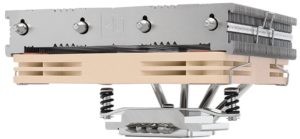
- CPU: Intel Core i7-4790K
- Motherboard: ASRock Z97E-ITX/AC
- RAM: Crucial 2x4GB DDR3L-1600 Kit
- Solid-State Drive #1: Toshiba OCZ Trion 150 960GB
- Power Supply: SilverStone SST-SX500-G
- CPU Cooler: Noctua NH-L12S
- OS: Microsoft Windows 10 Home
By the way, we should just mention once again that because we are using the 70mm cooler, we did not use the included 120mm fan, nor did we use an optical drive (although we had one that could fit, as installed in the RVZ02 chassis pictured earlier on this page). For the record, the much larger RVZ02/ML08 actually has a CPU cooler limit of 58mm, which goes to show how truly optimized the tiny ML09 is.
Next we’ll give our thoughts on assembly and performance.
Assembly
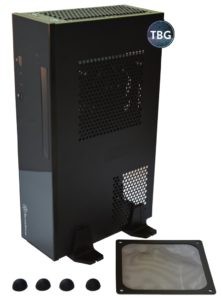
One thing that’s really great about the ML09 is that it can truly be used either vertically or horizontally. In the box you get plastic “bookend” stands that allow you to stand it up on its side, and you also get four chunky stick-on rubber feet for positioning the ML09 horizontally on a shelf, as you would in a media center. Also in the box is a magnetic fan filter, which you attach to the outside of the case if using the supplied intake fan (we didn’t use the filter as our CPU cooler used an exhaust setup, which doesn’t require a filter). Thanks to the sturdy steel spine running down the center of the ML09, it can also hold the weight of components stacked on top… assuming you don’t fill the case to its limits, which brings us to the assembly process. SilverStone has done quite a lot of smart engineering to make the ML09 come together, but the user will still need to do a little trial and error to learn exactly what it’s capable of. Better yet, you can just keep reading this review and learn all the options and limitations!
So, as we mentioned on the previous page, in order to start assembly, you must do quite a bit of disassembly. We’ve put together something of an “exploded” view below to show you exactly what’s in the case, and what needs to come out in order to put a system together in it. You have the four-slot 2.5″ drive cage, the multi-purpose bracket with pre-installed 120mm fan, and you also have the steel brace, which we’ve left in the case for this photo (but removed later on, as you’ll see in the next photo). Note that in order to install an optical drive or a 3.5″ hard drive, you must remove the 120mm fan as well, as it cannot be used in tandem with those components.
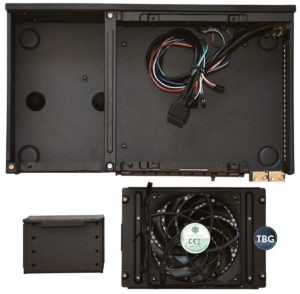
Moving on to the “assembly” process, we started by installing our 2.5″ drive into the cage, and then dropping it into the case. We then went to install the power supply, and realized that it would be impossible with the cage in place! So out came the cage again and in went the SilverStone SX500-G power supply. The issue is that with the cage installed, you have no clearance for the modular cables. One interesting “off-label” use of the ML09 is that you can actually install a more powerful SFX-L power supply in the case if you chose to forego the 2.5″ drive all together. That’s a pretty niche use case, but if you just use a single M.2 based SSD, you can indeed go ahead and choose a premium SFX-L unit, like the silent SilverStone NJ450 Platinum-rated unit. You could also go with something like the SilverStone SX800-LTI Titanium-rated unit, but honestly, there’s just no reason to do so unless you really want the most efficient ITX system ever. Because you’re quite limited in the video card and motherboard options for this case, there’s no way you could ever touch the 800W rating of that unit. For most folks, we’d suggest sticking with a shorter SFX model, but the SFX-L models do offer some interesting options for a “tricked-out” rig.
In terms of drive storage, you have the four 2.5″ drive slots in the cage, the option of a 3.5″ drive or tray-loading optical above the motherboard, and of course an M.2 drive (or two) depending on your motherboard selection. We’d recommend that just about everyone skip the 3.5′ drive option, as it limits you to a 37mm-tall CPU cooler without providing much benefit. The optical drive option is more viable, as it’s compatible with Intel’s stock cooler (though notably, not AMD’s stock 55mm Ryzen cooler). As mentioned, we chose another path: maximizing our CPU cooler potential by going all the way up to a 70mm model. As shown below, this was not exactly a trivial matter:
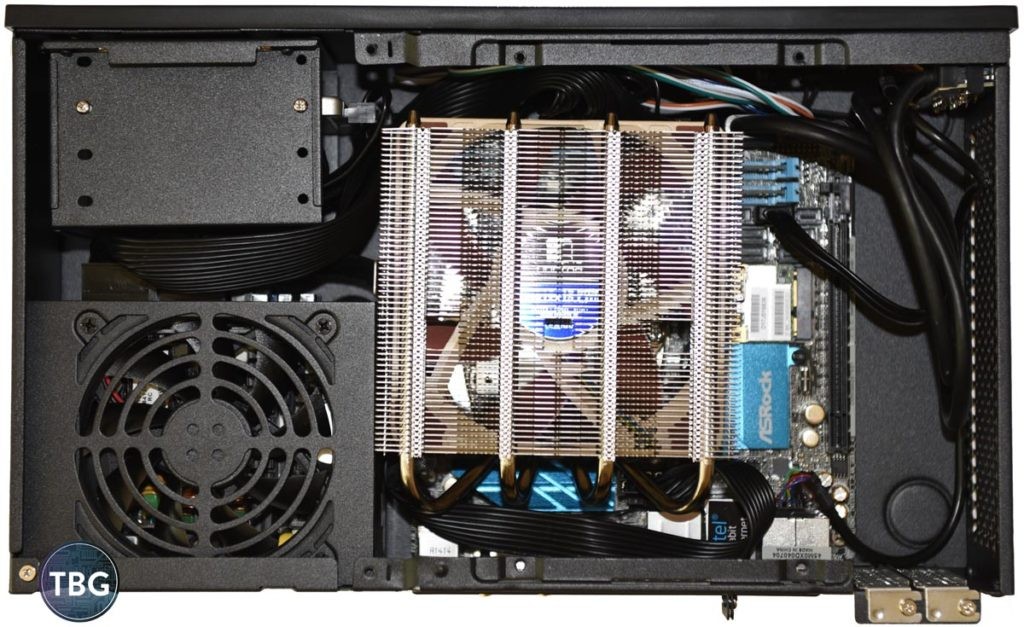
Yes, indeed, everything fit, but we had exactly 0mm of clearance. Due to the somewhat high position of the CPU socket on our AsRock Z97 motherboard, the cooler is offset and hanging way off the size of the motherboard, and in fact strikes the PSU. We tried every other orientation, and none worked. Note that newer ITX boards have more-or-less standardized on a CPU socket position in the middle of the board, which would allow our big Noctua NH-L12S a little more breathing room. One thing to note in our build is that the steel cross-brace simply could not be used with the NH-L12S installed, but if our motherboard used a different socket position, it’s possible it could have remained in place. As we noted previously, we didn’t have a low-profile video card to test with this system, so the expansion card section of the case remained empty, although it was a good place to stash the bulky front panel USB 3.0 cable. If you’re installing a video card, prepare to do some wrangling of that cable to make it fit in the case.

Performance
Because we used such a different platform for this test, we can’t directly compare it to other cases, but overall, we were incredibly impressed with the final build in the ML09 chassis. It used a quiet, efficient Gold-rated SFX power supply, had plenty of space for 2.5″ drives, and fit our favorite low-profile cooler ever released, the Noctua NH-L12S, which by the way is insanely quiet. And thanks to its use of an updraft fan, it worked to cool not only the CPU, but the case interior overall by pushing hot air out of the case. One small gripe we had was that the heatsink didn’t quite line up with the small vent on the top of the chassis, meaning overall cooling capacity was slightly reduced. Again, had our motherboard used a more centered socket position, this wouldn’t have been as serious an issue. In any event, the result was a compact, quiet, powerful, and very stylish PC, which we’re pretty sure anyone would be happy to have on their desk or in their AV system.
Conclusion
There’s just no other way to put this: the SilverStone ML09 is a one-of-a-kind case in the SFF market. It perfects the design that SilverStone first released back in 2013 with the ML05, and makes a solid foundation for any high-end home theater or home office mini-PC. Use can even use it with an Intel CPU and a low-profile video card like the Gigabyte Geforce GTX 1050 Ti OC, or alternatively install an AMD Ryzen 5 2400G, to create a very competent gaming system that is unequaled in terms of size. Simply put, it offers a huge range of options in one sleek, affordable chassis, which means that despite its inherent limitations, we give it a perfect score.
The SilverStone ML09B is available for $59.99 shipped free from Amazon, and it earns a recommendation in our new $1,000 Ultra-Slim ITX Gaming/HTPC Buyer’s Guide. To see all of our recommended cases, simply browse TBG’s PC Buyer’s Guides, which highlight our top 24 favorite cases on the market!


